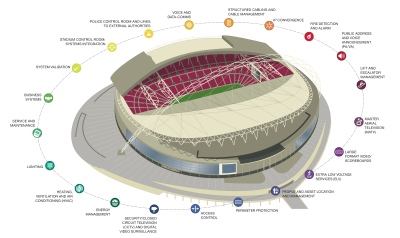How building smart can boost a business

Smart buildings have the potential to respond to a host of issues that will improve the efficiency and effectiveness of a business. Matthew Eastwood of Honeywell Building Solutions explains the benefits for business and the substantial cost savings that can be achieved.
Let me ask a question. How do you define success in your organisation? Your answer may well include references to profit and budgetary control, customer service and satisfaction, and workforce stability and effectiveness.
However, achieving success in these areas requires attention to the following.
• Managing operating and capital expenditures, and enhancing bottom-line profitability by continually improving efficiencies.
• Increasing revenue, strengthening customer loyalty and gaining a competitive advantage by offering additional services.
• Providing a safe, secure and comfortable environment for staff and customers alike.
Sustainability and corporate social responsibility are also pressing concerns for many companies. Plus, while regulatory compliance may not make it onto the wall poster, it will undoubtedly be lurking somewhere in the background.
Attaining all of these objectives depends on building an economical, flexible and agile infrastructure that supports the business model — infrastructure that can evolve to support any changes or additions to that model over time.
This is why a growing number of organisations are embracing smart technology when building or upgrading their facilities.
Getting smart, effective and efficient
A smart building hosts and integrates a broad range of systems required for the management of the building and enterprise operations on one powerful IT network. Building management, fire, security, energy management and business systems are all brought together via a single user interface to provide a facility that is secure, cost-effective, energy-efficient and easy-to-operate. This approach also lowers the cost of installation — an integrated system requires less cabling and hardware up front, for instance — and reduces the total cost of ownership.
The longer a smart building operates, the more data it collects. The more data it collects, the better its decision making. The better its decision-making, the smoother the operation, the greater the savings and the broader the organisational growth opportunities. And that’s just the start.
Integrating a range of building control and management IT systems on one secure, resilient, flexible and future-proofed network helps businesses comply with legislative requirements, enables the quick and seamless adoption of new technologies and provides unrivalled opportunities to drive down costs and enhance the bottom-line — both today and tomorrow.
Turning facilities into a genuine asset
Creating a smart building that satisfies enterprise requirements across the organisational spectrum means taking an holistic view of the operation and using the results to integrate a range of diverse technologies, including those from third parties, onto a single, scalable and powerful IT platform.
Integrating building management systems with business processes such as human resources, supply chain, marketing and financial systems provides greater strategic control over the entire business.
It creates synergies, reduces complexity, provides a clear and comprehensive insight across facilities and enables measures to reduce energy use and improve options to be identified and implemented quickly and effectively. These measures can lead to innovative cause-and-effect scenarios that can be developed and incorporated into the common platform.
For example, in the event of a fire alarm being activated somewhere in the Liverpool ONE shopping, residential and leisure complex, the cameras in the affected location would immediately rotate to identify whether there is a real threat of fire. If the concern is legitimate, the plasma screens located throughout the complex flash messages indicating the nearest emergency exits to the public. In turn, the doors on the emergency exits unlock and automatically open, allowing occupants to escape as quickly and as safely as possible.
Although operators in the control room are immediately alerted to the incident, the network facilitates this process without manual intervention.

For the Liverpool ONE community, which includes apartments and retail tenants, a dedicated website and IP telephony — the same infrastructure used for alarm management and emergency communication — supports new standards of service provision and convenience. Residents utilise EPOS to order fast-food deliveries and book cinema tickets, while retail tenants can call on a wide range of facilities-management services.
The smart solution also provides Liverpool ONE with the data, the intelligence and the response and control capabilities required to continually improve its operations and to develop and maximise its revenue streams.
For example, a combination of CCTV analytics and footfall statistics recognises the entrances and exits with maximum pedestrian traffic. This innovation has led to the creation of targeted advertising in those areas, generating additional revenue and increasing real-estate rental values in and near those localities.
Generating cost savings and operational efficiencies
Maintaining one network with a simplified organisational structure means a more efficient use of employees, technology and facilities. It also streamlines the administrative burden by reducing the number of vendors and leasing contracts to be accommodated.
This allows users to focus on activities aligned with the organisation’s key aims and objectives. And these activities are easier to implement, monitor and tweak — thanks to the improved planning, measurement and reporting of key performance indicators within the facility.
In addition, a smart building improves energy management and cuts life-cycle costs by reducing expenditure associated with equipment and maintenance, network administration and carrier charges, and the requirement for physical space.
It aids budgeting by providing better visibility of future costs, and helps to identify and justify the case for enhancements, with the ability to add new technologies from a variety of vendors as they arise, using the installed, open IT backbone.
Improving facilities management
Underpinning all the added-value benefits a smart building brings to an organisation are the advantages the technology brings to ‘traditional’ facility management.
Bringing disparate systems together on the one network cuts the time needed to learn separate interfaces and thereby reduces the training requirement. Installing the one network lowers the overall installation cost in terms of time as well as money.
Energy efficiency and operational efficiency are both enhanced, reports are consistent, and system security is improved. Collating the data, presenting it in useful formats and implementing the consequent decisions quickly and effectively makes regulatory compliance straightforward and facilitates a swift response to events, alarms, other problems and opportunities.
The power of a smart building to generate savings, create value, enhance operations and improve results in any organisation is increasingly being recognised by consultants, developers, contractors and building owners and users.
According to market intelligence provider IDC, the smart-building market is expected to triple in size over five years to around £14.5 billion per annum* as a growing number of organisations take advantage of the benefits smart technology creates across their business.
I started with a question. Let me finish with a question. Question two. Will you be among them?
Matthew Eastwood is general manager UK with Honeywell Building Solutions.
* Global Smart Buildings Forecast 2013-2018 (Doc #EI247447) IDC Energy Insights







